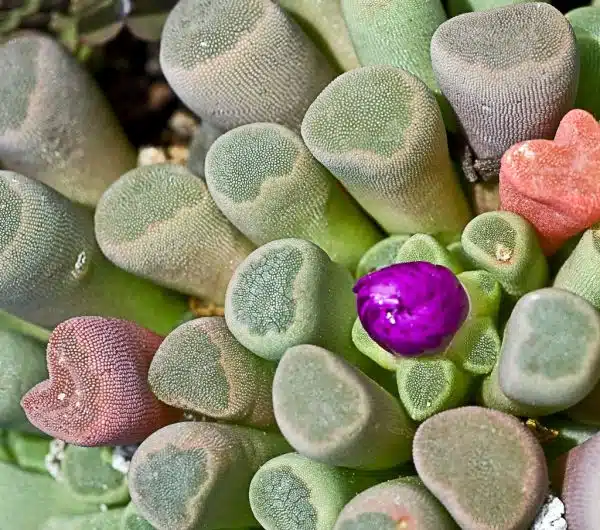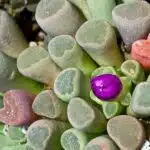Succulents are often chosen for their low-maintenance and drought-tolerant qualities, making them a popular choice among gardeners. However, some succulent owners may notice that their plants are growing unusually tall, which can be confusing as these plants are typically known for their short and stubby appearance. Understanding why succulents grow tall is essential in ensuring the healthy growth of these plants.
There are several reasons why succulents may grow tall, including environmental factors such as light and temperature, nutrient imbalances, and genetic factors. As a horticulture writer, it is important to educate readers on the intricacies of plant growth to help them better care for their plants. By providing insights into the causes of succulent elongation, this article aims to assist gardeners in maintaining healthy and vibrant succulent gardens.
Succulent Anatomy And Growth Patterns
Succulents are fascinating plants that store water in their leaves, stems, and roots. They come in different shapes, sizes, and colors and are native to arid regions around the world. According to recent research, there are over 10,000 species of succulents belonging to more than 60 plant families.
Succulent propagation is relatively easy and can be done by stem or leaf cuttings. Stem cuttings involve removing a piece of stem from the parent plant and allowing it to dry for a few days before planting it in well-draining soil. Leaf cuttings involve removing a healthy leaf from the parent plant and allowing it to dry for about a week before planting it in moist soil. Both methods require patience as succulent growth can take some time.
Pruning techniques are essential for maintaining the health and shape of your succulent. Regular pruning helps remove dead or diseased parts of the plant and encourages new growth. It’s important to use sterile pruning shears when cutting back your succulent as this reduces the risk of infection. By understanding how succulents grow, we can apply different pruning techniques that help control their height, width, and overall appearance. In the next section, we will explore environmental factors that affect succulent growth such as light exposure, temperature fluctuations, watering frequency, and soil type.
Environmental Factors Affecting Succulent Growth
Succulent growth is influenced by various environmental factors. One of the most critical factors that affect succulent growth is watering frequency. Overwatering or underwatering can make the plant grow tall and lanky or stunted, respectively. Succulents are adapted to dry environments, and they store water in their leaves and stems, which means they don’t need frequent watering like other plants. Therefore, it is essential to find a balance when watering your succulent to prevent it from growing too tall.
Pot size is another environmental factor that affects succulent growth. A pot that is too small for the plant will constrain its roots’ growth, limiting its ability to take up nutrients and water from the soil. On the other hand, a pot that is too large can lead to overwatering since the soil will hold more moisture than necessary. Therefore, it’s crucial to select an appropriate pot size for your succulent based on its size and growth rate.
In conclusion, several environmental factors influence succulent growth, including watering frequency and pot size. Understanding these factors can help you care for your plant better and prevent it from growing too tall or becoming stunted. However, there’s still one more critical factor that affects succulent growth: light. The next section will explore how light influences succulent growth and what you can do to ensure your plant gets enough light to thrive.
The Role Of Light In Succulent Growth
Sunlight is essential for the growth of succulents, providing essential energy for photosynthesis and the subsequent production of carbohydrates. Artificial light, such as LED lighting, can also provide adequate light for succulents, although it does not contain the same intensity or spectrum of wavelengths as sunlight. Prolonged exposure to sunlight can lead to sunburn, while artificial light can cause succulents to grow too tall, leading to a weakened stem structure. Therefore, it is important to maintain a balance between sunlight and artificial light when growing succulents.
The Effects Of Sunlight
As succulent enthusiasts, it is not uncommon to see our plants grow tall and spindly. One possible reason for this phenomenon is sunlight duration. Succulents thrive in bright light, but too much or too little can cause them to stretch upwards. When a succulent receives insufficient light, it will try to reach higher up towards the sun to get more. Conversely, if it receives too much direct sunlight, its leaves may become scorched and it will elongate as a way of avoiding the intense rays.
Soil quality also plays a crucial role in determining the growth of succulents. If the soil is too rich and retains too much moisture, the plant becomes more prone to rotting rather than growing upwards. On the other hand, if the soil is too loose or sandy, it doesn’t provide enough support for root growth and can stunt overall development. Therefore, proper care must be taken when choosing soil type and watering habits.
In conclusion, sunlight duration and soil quality are two major factors that contribute to a succulent’s tendency to grow tall or remain compact. By ensuring that these variables are optimized for your specific plant species and environment, you can help your succulent thrive and maintain its ideal shape.
The Effects Of Artificial Light
Light plays a significant role in the growth of succulents, and it is essential to ensure that your plants receive adequate light for optimal growth. While natural light is the best source of light for indoor plants, different types of artificial light can also be used to supplement their growth. The use of artificial lights has become increasingly popular among indoor gardeners, especially during winter when natural sunlight is scarce. However, it is crucial to understand how different types of artificial lights affect succulent growth.
The effects of artificial light on succulent growth vary depending on the type of bulb used. Incandescent bulbs emit more red wavelengths and are not suitable for plant growth as they produce too much heat and not enough blue light that promotes healthy foliage. On the other hand, fluorescent bulbs are an excellent option for indoor gardening as they emit more blue wavelengths, which encourage compact growth and healthy foliage. LED grow lights are also becoming more popular due to their energy efficiency and ability to provide specific wavelengths that promote plant growth.
When using artificial lights for your succulents, it is important to remember that they should not be a substitute for natural sunlight but rather a supplement. Succulents require periods of darkness to rest and cannot thrive under constant lighting. Therefore, it is recommended to provide 12-14 hours of light per day with a minimum of six hours of darkness. By understanding the effects of different types of artificial lights on succulent growth and providing them with proper lighting conditions, you can help your plants thrive even in low-light environments.
Temperature And Humidity’s Effect On Succulent Growth
As discussed in the previous section, light plays a significant role in succulent growth. However, if your succulent is growing tall and leggy despite receiving adequate light, temperature and humidity could be the culprits. Succulents thrive in warm environments with temperatures ranging between 60 to 80 degrees Fahrenheit. If the temperature drops below this range, it can cause stunted growth or even death. On the other hand, excessively high temperatures can also harm succulents by causing dehydration and sunburn.
Humidity control is another crucial factor that affects succulent growth. Succulents originate from arid regions where humidity levels are low. Thus, they have adapted to survive with minimal water and high temperatures. When placed in a humid environment, succulents absorb excess moisture through their leaves and stems, leading to rotting roots and fungal infections. Therefore, it’s essential to provide adequate ventilation to prevent humidity buildup around your plants.
Maintaining optimal temperature regulation and controlling humidity levels are crucial for healthy succulent growth. Failure to do so can result in various problems such as pests infestation and diseases caused by fungi and bacteria. In addition, nutrient imbalances can also affect succulent growth adversely. We will discuss this further in the subsequent section about nutrient imbalances and their impact on succulent growth.
Nutrient Imbalances And Their Impact On Succulent Growth
Fertilizer overdose is a common problem when growing succulents, as it can lead to a build up of salts and other minerals in the soil, resulting in poor growth and even death. Nitrogen deficiency is another common problem which can result in succulents exhibiting stunted growth and yellowing of the leaves. A potassium overdose can occur when the levels of potassium in the soil become too high, leading to a reduction in the plant’s ability to absorb water and nutrients, resulting in wilting and stunted growth. These nutrient imbalances can have a major impact on the growth and health of succulents, and should be carefully monitored and managed.
Fertilizer Overdose
Succulents are popular plants due to their unique and attractive appearance, as well as their ability to thrive in a variety of conditions. However, many succulent owners may find themselves facing the problem of their plant growing tall and spindly rather than compact and sturdy. One common mistake that can lead to this issue is a fertilizer overdose.
Over-fertilizing succulents can result in an excess of nutrients that can cause the plant to grow too quickly and become weak and leggy. This is because succulents naturally have a slow growth rate and do not require frequent fertilization. When given too much fertilizer, they may also be more susceptible to sunburn or pest infestations. To avoid this problem, it is important to use a balanced fertilizer with low nitrogen levels specifically formulated for succulents. Healthy alternatives include using organic soil amendments or simply allowing the plant’s natural growth process to occur.
In conclusion, while adding nutrients through fertilization is essential for healthy succulent growth, it is important not to overdo it. A fertilizer overdose can lead to a range of issues including leggy growth and susceptibility to pests or disease. By following proper fertilization practices and being mindful of the needs of these unique plants, succulent owners can enjoy vibrant, healthy plants for years to come.
Nitrogen Deficiency
Succulent owners should also be aware of the impact of nutrient imbalances, particularly nitrogen deficiency, on the growth and health of their plants. Nitrogen is an essential macronutrient that promotes leaf and stem growth while also enhancing the plant’s overall color and vitality. However, a lack of nitrogen can lead to stunted or discolored leaves, slow growth, and general weakness.
Common causes of nitrogen deficiency in succulents include poor soil quality, infrequent fertilization or using an unbalanced fertilizer with low nitrogen levels. To remedy this issue, succulent owners can incorporate organic sources of nitrogen such as compost or manure into their soil mix. They can also use a balanced fertilizer with higher levels of nitrogen to promote healthy growth. Additionally, ensuring proper watering practices can also aid in preventing nutrient imbalances and deficiencies in succulents.
In summary, while over-fertilizing succulents can lead to leggy growth and other issues, it is equally important to ensure that they receive adequate amounts of key nutrients like nitrogen. Succulent owners who are mindful of these factors will be able to enjoy vibrant and thriving plants for years to come by providing them with optimal growing conditions.
Potassium Overdose
Another nutrient imbalance that succulent owners should be aware of is potassium overdose. Potassium is another essential macronutrient that plays a vital role in plant growth and development, including enhancing root growth, flower quality, and overall stress tolerance. However, too much potassium can lead to several issues that can negatively impact succulent health.
Symptoms of potassium overdose in succulents include yellowing or browning of leaf tips, leaf burn or scorching, and reduced growth. The excess buildup of potassium ions can also disrupt the balance of other nutrients in the soil, leading to potential deficiencies in calcium and magnesium. To remedy this issue, succulent owners should avoid over-fertilizing their plants with high-potassium fertilizers. Instead, they can opt for balanced fertilizers with equal amounts of nitrogen, phosphorus, and potassium.
Prevention and maintenance practices are key to ensuring proper nutrient levels in succulents. It is crucial to test soil regularly for nutrient imbalances and adjust fertilizer applications accordingly. Succulent owners should also be mindful of watering practices as overwatering can lead to leaching of nutrients from the soil. Incorporating organic matter into the soil mix can also help improve soil fertility and nutrient availability for succulents.
In conclusion, while adequate nutrition is crucial for healthy succulent growth, it is equally important to maintain proper nutrient balance to avoid any toxicity issues caused by an overdose of certain macronutrients like potassium. By implementing appropriate preventive measures and maintenance practices such as regular soil testing and using balanced fertilizers with equal amounts of macronutrients, one can ensure optimal conditions for growing vibrant and thriving succulents.
Overwatering And Its Consequences For Succulents
As the saying goes, “too much of anything is bad.” This applies to succulents as well, especially when it comes to watering. Overwatering is one of the most common mistakes succulent owners make, and it can lead to a wide range of issues, including elongated or tall growth.
Identifying overwatering signs can be tricky, but there are a few telltale signs that you should keep an eye out for. One of the most obvious signs is yellowing leaves, which indicates root rot caused by too much moisture in the soil. Soft or mushy leaves are also a sign of overwatering and can indicate that the roots have started to rot. Additionally, if your succulent starts growing tall and spindly rather than remaining compact and full, this could be another sign that it’s getting too much water.
Preventing overwatering damage requires a bit of care and attention on your part. First and foremost, make sure that you’re not watering your succulent too frequently. Most succulents only need to be watered once every two weeks or so, depending on the climate and time of year. It’s also important to use well-draining soil and pots with drainage holes to help excess water escape. Finally, pay attention to your plant’s overall appearance and adjust your watering schedule as needed based on its specific needs.
Next up: underwatering and its effect on succulent growth.
Underwatering And Its Effect On Succulent Growth
Having understood the adverse effects of overwatering on succulents, it is essential to know how underwatering affects their growth. Succulents are known for their ability to store water in their leaves and stems, which allows them to survive in arid conditions. However, if they do not receive adequate water, they may become dehydrated and start growing tall.
One of the signs of underwatering is the wrinkling or shriveling of leaves. The leaves will also appear dry and brittle, indicating that the plant is not receiving enough moisture. Another sign to look out for is yellowing and dropping of leaves, which can be an indication that the plant is stressed due to lack of water. Additionally, a succulent that is underwatered may grow taller than usual as it tries to reach for sunlight.
To overcome underwatering, it’s crucial to ensure that your succulent receives enough water without overdoing it. The best way to determine when your plant requires watering is by checking its soil moisture levels. Water your plant thoroughly but avoid leaving excess water in its saucer as this can lead to root rot. It’s also advisable to use well-draining soil and pots with drainage holes.
Understanding the genetics of succulent growth can help you make informed decisions on how best to care for your plants’ unique needs. Some succulents naturally grow tall while others remain short and compact. Knowing which variety you have can allow you to provide optimal conditions for its growth. Proper watering habits coupled with an understanding of your plant’s genetics will help you maintain healthy and thriving succulents in your home or garden.
Understanding The Genetics Of Succulent Growth
The towering succulent is a sight to behold, its upright structure an admirable feat of nature. However, many gardeners may find themselves perplexed by the unusual growth pattern of their precious plant. Succulent enthusiasts may attribute this phenomenon to genetic mutations or evolutionary adaptations that have occurred over time.
Genetic mutations are a common occurrence in plants and can result in various physical traits, including elongated stems or leaves. In some cases, these mutations can be desirable and contribute to the plant’s aesthetic appeal. Still, it could also be a sign of an underlying problem such as inadequate lighting or insufficient nutrients.
Evolutionary adaptations are another possible explanation for succulent elongation. These plants are capable of adapting to their environment over time, and sometimes this means growing taller to reach more sunlight or escaping from predators. Gardeners should consider both genetic mutations and environmental factors when attempting to understand the reason behind their succulent’s vertical growth.
As fascinating as tall succulents can be, they may not always fit into a gardener’s ideal landscape design. Fortunately, there are techniques for preventing succulent elongation without sacrificing the plant’s health or stunting its growth potential. These methods include adjusting light exposure and temperature levels or pruning back excess foliage regularly. By implementing these techniques, gardeners can ensure that their succulents maintain their compact form while still thriving in their environment.
Techniques For Preventing Succulent Elongation
Understanding the Genetics of Succulent Growth has provided insight into why succulents tend to grow tall. However, it is essential to prevent elongation if you want your succulent garden to maintain a healthy and vibrant appearance. Potting techniques are one way that can help prevent succulent elongation.
Using a smaller pot will keep your succulent’s roots confined, preventing excess stretching. Moreover, the soil in which they are planted should be well-draining and nutrient-rich to ensure their optimal growth. It is also crucial to monitor the amount of sunlight your plants receive, as too much sun can cause them to stretch out in search of more shade.
Another effective method for preventing succulent elongation is pruning. Regular pruning helps control the size and shape of your plants and promotes bushier growth. When you remove the top portion of a plant, it will trigger new lateral growth that results in a fuller appearance.
In conclusion, using appropriate potting techniques and regular pruning methods can help prevent succulent elongation and maintain healthy and vibrant gardens. By following these practices, you can enjoy your beautiful plants without worrying about them growing too tall or losing their distinctive shapes. In the next section, we will discuss some tips for maintaining healthy and vibrant succulent gardens.
Tips For Maintaining Healthy And Vibrant Succulent Gardens
As succulent gardens become increasingly popular, gardeners must learn to care for their plants properly. Succulents are low-maintenance plants that require little water and thrive in bright, indirect light. However, overwatering or placing a succulent in direct sunlight can lead to problems such as tall growth.
One way to maintain healthy and vibrant succulent gardens is by creating creative arrangements. Succulents come in a vast range of colors, textures, and shapes, making them perfect for creating unique displays. Gardeners can mix different varieties of succulents to create visually stunning arrangements that add interest and beauty to any outdoor space.
Propagation techniques are also essential for maintaining a thriving succulent garden. Propagating succulents is easy and can be done through leaf or stem cuttings. By propagating the plant instead of buying new ones, gardeners can save money while also ensuring that their garden remains healthy and vibrant for years to come.
In summary, maintaining a healthy and vibrant succulent garden requires proper care and attention. Gardeners should avoid overwatering or placing their succulents in direct sunlight to prevent tall growth. Additionally, they can create creative arrangements and use propagation techniques to ensure a thriving garden full of beautiful plants.
Conclusion
Succulents are fascinating plants that have unique anatomical features and growth patterns. However, when a succulent grows tall instead of maintaining its compact form, it can be a sign of environmental stress or genetic factors. Light, temperature, humidity, nutrients, and water all play a significant role in the growth of succulents.
Light is essential for photosynthesis and influences the color and pattern of the leaves. Temperature and humidity affect the opening and closing of stomata, which regulate water loss. Nutrient imbalances can cause stunted or elongated growth, while underwatering can lead to root damage and reduced growth.
To prevent succulent elongation, gardeners can use techniques such as pruning or propagating to encourage bushier growth. Maintaining healthy soil with proper drainage and watering habits is also crucial for succulent health.
In conclusion, understanding the factors that influence succulent growth is critical for maintaining healthy and vibrant gardens. By providing optimal light conditions, temperature and humidity levels, nutrient balances, and watering schedules, gardeners can promote bushy rather than elongated growth in their succulents. With care and attention to detail, these resilient plants will thrive in any environment.
Image Credits
- “Very Strange Succulent” by Steve Corey (featured)





























